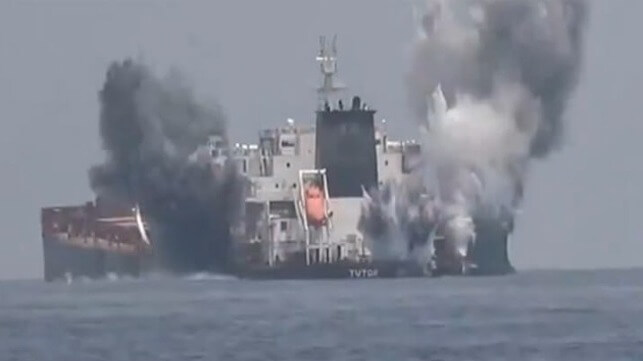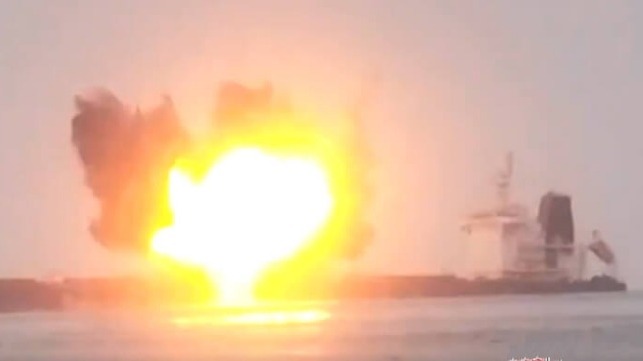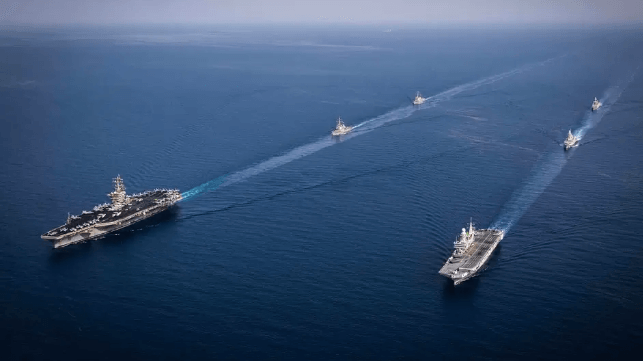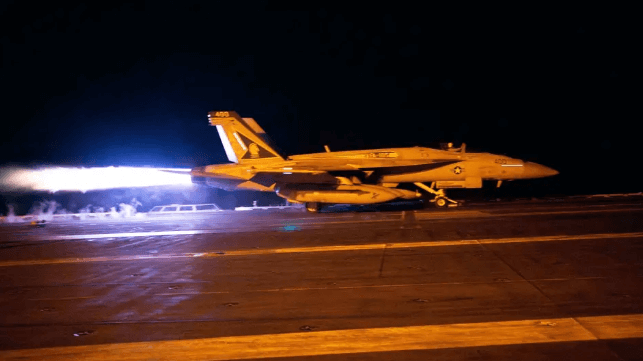UPDATED
Houthis Confirm Boarding Tutor While Threatening Another Ship in Escalation

The leadership of the Houthis confirmed in a televised speech that its forces had hastened the sinking of the bulker Tutor earlier in the week while making a similar threat to the abandoned bulker Verbena still afloat and drifting in the Gulf of Aden. This came as the leader of the EU operation said in an interview that its force needed to be expanded to counter the current escalation by the Houthi.
Citing what he called the “fourth stage of the escalation,” the declared leader of the Houthi Abdul-Malik al-Houthi during the televised speech said his followers were “able to board the ship Tutor, and booby-trapped it and blew it up after it was first hit by a military boat.” This is consistent with the images released showing multiple explosions at the stern of the disabled ship which had been abandoned and was drifting in the Red Sea.
There had been similar unconfirmed allegations in March that the Houthi also boarded the Rubymar, a bulker carrying fertilizer to Lebanon, and also sabotaged it causing the vessel that had been drifting for days to suddenly sink. The Houthi were able to reach both vessels after the crews abandoned ship and before salvage teams arrived at the vessels.
During the speech, the Houthis said “There is a second ship that is about to sink in the Gulf of Aden.” It was a veiled threat to carry out a similar operation on the Verbena which they had earlier asserted had already sunk. The ship was abandoned when the crew was unable to control a fire started by the Houthi attack. Unconfirmed reports said a salvage team is being organized for this vessel.
The Houthi asserted that they had conducted 10 operations with 26 missiles, drones, and one boat over the past week. They said eight ships were targeted bringing the total to 153. Their strong claim, flatly denied by CENTCOM and officers on the aircraft carrier USS Dwight D. Eisenhower, was that they had targeted the Eisenhower for a third time in the northern Red Sea “with missiles and chasing it.”
The Operational Commander for EU NAVFOR Aspides spoke with Bloomberg marking four months of the operation. Rear Admiral Vasileios Gryparis said in the interview that they have escorted 164 ships while shooting down more than a dozen unmanned aerial vehicles and four anti-ship ballistic missiles. Despite having four warships, he said the operation is limited due to the scope of the area to “A small part of the southern Red Sea, near the Bab el-Mandeb Strait.”
Rear Admiral Gryparis Admiral told Bloomberg that the force needs to be more than doubled because of the escalation. On June 19, he also presented to the European Union Military Committee the revision of the Operation Plan for Aspides.
Unconfirmed reports are that the U.S. currently has three warships in addition to the Eisenhower in the region. The Houthis acknowledged that the “Americans and British carried out 24 raids this week,” while saying they had no effect. CENTCOM however reported that ground control and radar installations were destroyed. They also reported destroying many of the uncrewed surface vessels over the past week including four more in the last 24 hours.
Video: Houthis Show Methods Used to Sink the Bulker Tutor

The Houthis released a propaganda video on social media showing the attacks on the bulker Tutor which was lost on Tuesday a week after the vessel was struck. In addition to showing the attacks, it appears to show that they hastened the demise of the vessel, something that was also rumored but not confirmed for the Rubymar in March.
According to the statement from the Houthi military forces, they warned Evalendar Shipping that it had violated their ban on ships calling in Israeli ports. The Houthis contend that the Greek company’s vessel Shimanami Star (28,500 dwt and registered in the Bahamas) had made a port call in Haifa on an unspecified date. They are also reporting that the Tutor turned off its AIS signal while it was in the Red Sea, a commonly followed practice by many vessels.
“During its passage from the Red Sea, several naval weapons were used to target and sink the ship Tutor, including weapons used for the first time. We call on all shipping companies to take our warnings seriously, otherwise, they will bear full responsibility for the safety of ships and crews,” the Houthi military said in its statement.
The small boat can be seen approaching the vessel and the video captures the moment of impact.
Security consultants Ambrey in its Threat Circular last week described the attacks as being carried out with a fishing boat that is 5 to 7 meters (16 to 23 feet) in length and made of fiberglass or wood. The Houthis placed dummy figures in the boat in an attempt to disguise the threat. Ambrey writes that in past incidents a second skiff was in the area and believed to be controlling the radio-controlled vessel.
One of the attack boats washed up near the Bab al Mandeb Strait in January 2024. Ambrey reports it was found they said to contain 25 kg of C4 explosives and 50 kg of TNT. It had three electronic switches using contact switches for the detonation.
The video also shows a second explosion on the port side of the vessel which is consistent with the reports. However, viewers are asking if it was a second drone boat and not a missile or “unknown projectile” as described in the reports from the vessel and U.S. Central Command.
The Tutor was abandoned by the crew on Friday, June 14. U.S. and French forces coordinated the evacuation of the crew while salvage vessels were due to reach the bulker at the beginning of this week.
At the end of the Houthi video, the bulker is seen low at the stern which is consistent with the reports that its engine room was flooded. However, then there is a ring of explosions around the stern of the vessel raising the question of whether the Houthi set off additional charges to hasten the sinking. There were reports in March that a small boat was seen near the Rubymar which had been in a similar situation to the Tutor, drifting and sinking at the stern. Hours later videos showed the Rubymar plunging below the Red Sea.
CENTCOM reports that U.S. forces continued their efforts to target control capabilities after last week’s attacks. In the past 24 hours, they are saying forces destroyed two Houthi uncrewed surface vessels in the Red Sea similar to the one used on the Tutor. Separately, CENTCOM forces successfully destroyed one ground control station and one command and control node in a Houthi-controlled area of Yemen.
Report: After Months Battling Houthis, Navy Wants to Bring Eisenhower Home

After 250 in the Med and the Mideast, the USS Dwight D. Eisenhower has achieved the mantle of most-deployed carrier in the fleet - and the Navy wants to bring her home, according to a new report.
USS Eisenhower is stationed in the Red Sea to defend shipping interests from attack by Yemen's Houthi rebels. The terrorist group claims to have carried out multiple attacks on the carrier itself, and the Associated Press confirms that Houthi missiles have made it close enough that crewmembers in her strike group were able to watch air defenses in action. (The carrier's commanding officer confirms that Eisenhower has not, however, been hit or sunk - as often claimed by Houthi leaders.) While the ship is unharmed, the regular exposure to risk has Navy leaders concerned about the need to treat possible post-traumatic stress amongst the crew, according to AP.

An F/A-18 strike fighter takes off from USS Eisenhower to bombard Houthi targets, Jan. 2024 (USN)
Beyond fatigue, Eisenhower and her escorts are subject to the same laws of nature as any ship: extended deployments take a toll on material readiness. When routine maintenance cycles are disrupted, wear and rust begin to accelerate.
"We are constantly reminding the Department of Defense that we’re going to need to take a respite and a break, to try and get back to maintenance," said Rear Adm. Marc Miguez, the strike group's off-going commander. "These ships are floating around in seawater."
The possibilities for replacing Eisenhower with another supercarrier appear limited in the immediate term, according to AP, and the Pentagon could substitute a big-deck amphibious assault vessel carrying F-35B fighters - much like the rotation for USS Gerald R. Ford last year.
On Sunday, Rear Adm. Miguez was relieved of command in a regular rotation, and he will return to Washington to serve as the Navy's chief liaison to Congress. CSG-2 is now commanded by Rear Adm. Kavon Hakimzadeh, the former commanding officer of carrier USS Harry S. Truman. In a speech, 5th Fleet commander Vice Adm. George Wikoff called the Red Sea engagement "the Navy's finest moments since World War II," and he credited Miguez for its success.
"The Dwight D. Eisenhower Carrier Strike Group has done amazing things, more than any carrier strike group dating back decades. Every man and woman out here . . . [is] delivering decisive combat power to preserve freedom of the seas," Miguez said.
In recent weeks, open-source satellite imaging suggests that Eisenhower has operated in the northern half of the sea, far from Yemeni shores. This time period overlaps with an intensified campaign of Houthi attacks on civilian shipping, resulting in one death, multiple injuries and the loss of one merchant ship.
No comments:
Post a Comment